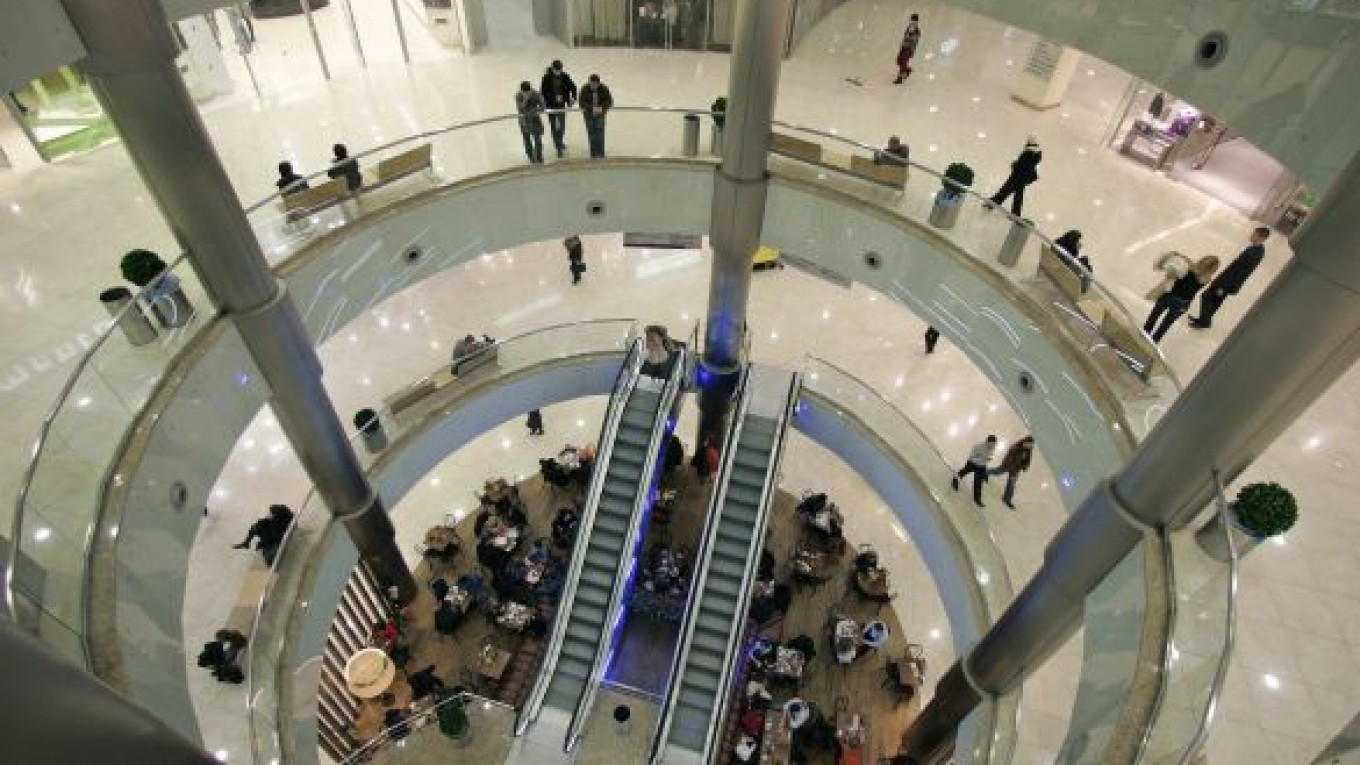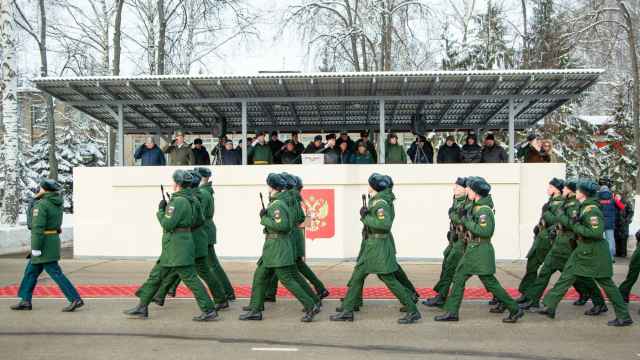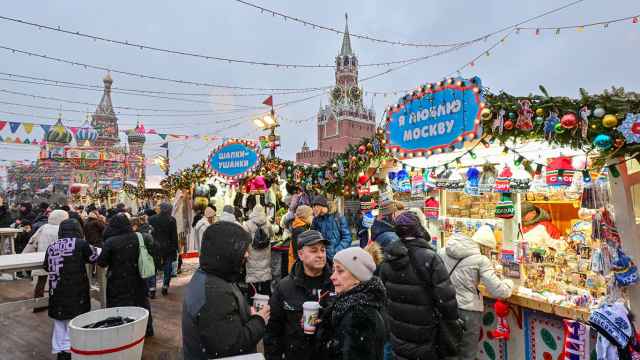Many owners of Moscow shopping centers were forced to repurpose and modernize their facilities because of the economic crisis, but so far their new developments have received little support from investors.
Of the city's shopping malls — totaling about 7 million square meters, according to Knight Frank — more than 30 percent are so outdated or in bad condition that they could be razed, said Mikhail Sverdlov, senior director of Cushman & Wakefield's retail property department in Moscow.
shopping malls
| Format | Square meters | $ per sq.m. |
| Anchor tenant | More than 3,000 | 100-200 |
| Mini-anchor tenant | 1,000-3,000 | 250-550 |
| Regular store | More than 600 | 400-650 |
| 300-600 | 700-1,200 | |
| 100-300 | 1,300-1,800 | |
| 50-100 | 1,600-2,300 | |
| Less than 50 | 2,000-3,000 |
Source: Magazin Magazinov in association with CB Richard Ellis
Citing a source in City Hall, RIA-Novosti recently reported that Moscow was planning to demolish the city's first hypermarket. Work was completed in 1997 on the modest Ramstore hypermarket — now known as Kapitoly — in the Kuntzevo district of western Moscow. The event was of such importance that then-Prime Minister Viktor Chernomyrdin attended the grand opening.
The demolition is likely just the opening bell for an emerging trend of dismantling professionally managed retail centers built in Moscow in the late 1990s, said Dmitry Burlov, executive director of Magazin Magazinov in association with CB Richard Ellis.
Virtually all of the city's retail centers need some sort of renewal. "They're like a living organism — something should always be changing," Sverdlov said.
Last year, renovations were done in the Atrium mall to add new space on the first and fourth floors and to change the food court, he said. The alterations gave the mall additional square meters of retail space — and brought in more shoppers.
For a long time, the 2,500-square-meter Tverskoi Passazh mall on Pushkin Square had very few shoppers, despite its extremely busy location, Sverdlov said. Several years ago, the owners changed the building's structure so they could give the entire first floor to cosmetics store Rive Gauche, resuscitating the mall.
Big changes are also under way for the Kapitoly mall, also a former Ramstore, on Leningradskoye Shosse, Sverdlov added. "There's a pitiable group of tenants" there now, said Dmitry Khechumov, executive director of real estate consultants Core Group. He cited last year's opening of the nearby Metropolis mall for drawing away customers.
Burlov, of Magazin Magazinov, said he thought that the Waymart in southern Moscow would also need to be redeveloped after the recent opening of the "more interesting" Vegas mall nearby.
Rental rates for retail space "did not change significantly" in the first half of the year, said Natalya Rudakova, of Magazin Magazinov. Those that did increase were because owners were ending discounts offered during the crisis, said Galina Maliborskaya, director of Colliers International's retail property department in Moscow.
In the spring, discounts were still as high as 30 percent, but those favorable terms are no longer available, she said. In malls that are thriving, "rental rates can be increased by up to 30 percent when new contracts are signed," Maliborskaya said.
New contracts for retail space are 10 percent to 15 percent more expensive than last year, said Lyubov Petrova, of NAI Becar.
"Rental demand for retail space has reached the pre-crisis level," said Yury Taranenko, director of Miel Kommercheskaya Nedvizhimost. "It's growing in Moscow and St. Petersburg, but also in the regions," Maliborskaya said.
Despite consultants and developers' assurances that the market is growing, vacant retail space is being occupied slowly. Moscow shopping malls have vacancy rates of between 10.5 percent (according to Knight Frank) and 18 percent (according to LCMC). New malls open with 20 percent to 40 percent of their space still available, hoping to find new tenants later, Petrova said.
In malls that are not professionally managed, sometimes 50 percent or more of the space is vacant, said Pyotr Isayev, director of Capital Group's commercial property department.
Zolotoi Vavilon Rostokino, Moscow's largest mall, has rental contracts signed for 90 percent of its space, according to Patero Development's press service. The company gave a similar figure — 80 percent occupancy — when asked by Vedomosti in November 2009 and March 2010.
Brokers, however, say the mall has a vacancy rate of 30 percent to 40 percent. "When Zolotoi Vavilon is full, we'll know that the market has recovered," said Denis Sokolov, a partner at Cushman & Wakefield.
Properties that are more successful, meanwhile, are already nearly full.
According to its press service, Vegas "has no free space," which brokers confirmed. The Rechnoi mall has 1.1 percent of its space free (Colliers). The Azovsky center, which opened the same month as Vegas, opened with just 20 percent of its space rented (Colliers).
Mall of Russia has signed rental agreements for 65 percent of its space, a figure the owner hopes to increase to 75 percent by the time the mall opens in December, said Natalia Ivanova, of AFI Development. In the Avenue 77 mall, which has planned its grand opening for the first quarter of 2011, 75 percent of the space is rented, Isayev said.
Much of the demand, like during the crisis, is from discounters. According to X5 Retail Group's results, like-for-like sales in the first half grew 4 percent in the company's stores in ruble terms, while the growth was 14 percent for its discount locations. The food retailer is also planning to open an ultra low-cost group of stores under the new brand Pyatyorochka-Maxi.
The O'Kei hypermarket chain is planning to bring a new grocery chain to Moscow called Zhyostky Diskaunter, while Metro may launch mini-wholesale hypermarkets under the Eco brand, which would be 3,000 to 3,500 square meters.
The average sales price per square meter of retail space varies from $3,000 in outlying residential neighborhoods to $15,000 within the Garden Ring, Petrova said. But there have been very few transactions.
"So far, investment activity hasn't turned into deals," said Sokolov, of Cushman & Wakefield. "It's hard to imagine now someone wanting to sell a shopping mall to invest in a new one."
Nothing new is in the works and "everything is revolving around existing space," he added.
"There continues to be no new construction announcements," analysts from Knight Frank wrote.
About 1 million square meters of retail space had been planned for completion in the second half of 2010, but Knight Frank estimates that no more than 600,000 square meters will actually be completed in the period. GVA Sawyer is forecasting a shortfall of new space by 2012-13.
The largest shopping centers now under construction — including River Mall, Tverskaya Mall and Gudzon — are slated to be finished next year, while virtually no projects are set to finish in 2012-13.
"Everyone is doing reconceptions," Sokolov said. Owners are simplifying projects, reducing their size, changing the type of space and looking for cheaper architectural options, he said. "Before people wanted to build a Disneyland, but now they're saying 'maybe a warehouse.'"
New high-end projects are generally linked to the development of existing ones. Crocus Group is continuing to implement "new, memorable details and possibilities for the Vegas brand. Two new Vegas locations have been announced — in Crocus City and on the 56th-57th kilometer of the Moscow Ring Road," the company's press service said.
Real estate brokers agreed that the trend now for new projects is to build something very expensive or something very cheap.
Two outlet centers will be built next year: Fashion House, on Leningradskoye Shosse, which will have 40,000 square meters and is being developed by GVA Sawyer, and Belaya Dacha Outlet Village, which will be 38,000 square meters and is developed by Hines.
Lee Timmins, senior vice president at Hines, said the company has deals signed or letters of intent for 60 percent of the first phase of construction, which will be 24,000 square meters.
In a survey of representatives of 100 brands that might be interested in renting space in the new outlet center, 80 percent of respondents told Hines that they believed the Russian market was ready for the new format.
Six years ago, when the company was only contemplating the project, "leading brands" were not ready, but the situation has changed now, said Andrew Muzzlewhite, the Hines development manager overseeing Belaya Dacha Outlet Village.
"No one knows for sure what consumers need," Sokolov said. "The main conclusion that developers have reached is to build according to their business models in hopes of later optimizing the project."
A Message from The Moscow Times:
Dear readers,
We are facing unprecedented challenges. Russia's Prosecutor General's Office has designated The Moscow Times as an "undesirable" organization, criminalizing our work and putting our staff at risk of prosecution. This follows our earlier unjust labeling as a "foreign agent."
These actions are direct attempts to silence independent journalism in Russia. The authorities claim our work "discredits the decisions of the Russian leadership." We see things differently: we strive to provide accurate, unbiased reporting on Russia.
We, the journalists of The Moscow Times, refuse to be silenced. But to continue our work, we need your help.
Your support, no matter how small, makes a world of difference. If you can, please support us monthly starting from just $2. It's quick to set up, and every contribution makes a significant impact.
By supporting The Moscow Times, you're defending open, independent journalism in the face of repression. Thank you for standing with us.
Remind me later.






